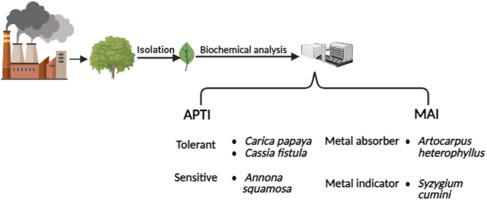城市砖窑周围空气污染的植物监测:探索植物修复污染物的潜力。
IF 8.1
2区 环境科学与生态学
Q1 ENVIRONMENTAL SCIENCES
引用次数: 0
摘要
本研究探讨了各种污染物对叶片生化参数(包括相对含水量 (RWC)、总叶绿素、叶片提取物 pH 值和抗坏血酸含量)的影响及其与空气污染耐受指数 (APTI) 的关系。相对含水量(RWC)是植物抗逆性的重要指标,它与 APTI 值呈显著正相关(r = 0.4503,p本文章由计算机程序翻译,如有差异,请以英文原文为准。

Phytomonitoring of air pollution around brick kilns in urban area: Exploring the potential of plants for the remediation of pollutants
This study examines the impacts of various pollutants on foliar biochemical parameters, including relative water content (RWC), total chlorophyll, leaf extract pH, and ascorbic acid content, and their relationship with the Air Pollution Tolerance Index (APTI). RWC, a crucial indicator of plant resilience, showed a significant positive correlation with APTI values (r = 0.4503, p < 0.05). Species with higher RWC, such as Carica papaya and Cassia fistula, demonstrated enhanced tolerance to pollutants, with RWC values reaching up to 85%. Chlorophyll content, which is vital for photosynthesis, exhibited a significant reduction in polluted areas, with levels ranging from 0.28 to 3.23 mg/g (p < 0.05). Notably, Cassia fistula had high APTI values but lower chlorophyll content, reflecting the complex relationship between tolerance and chlorophyll levels. Leaf extract pH was significantly lower in polluted areas, with pH values consistently below 7, correlating with higher APTI values (p < 0.05). Ascorbic acid content, an important antioxidant, was significantly higher in plants exposed to pollution, with positive correlations to APTI (r = 0.9214) and pH levels (r = 0.62). Principal Component Analysis (PCA) identified that pH, ascorbic acid, and APTI were positively correlated, while total chlorophyll and RWC showed opposing trends. Sensitivity analysis indicated that RWC (95.84% impact on Carica papaya and 85.92% on Cassia fistula) and pH were the primary factors influencing APTI and Metal Accumulation Index (MAI) values. The findings underscore the role of RWC, chlorophyll, pH, and ascorbic acid as biomarkers for plant responses to pollution and highlight the effectiveness of species with high MAI values in heavy metal accumulation and environmental monitoring.
求助全文
通过发布文献求助,成功后即可免费获取论文全文。
去求助
来源期刊

Chemosphere
环境科学-环境科学
CiteScore
15.80
自引率
8.00%
发文量
4975
审稿时长
3.4 months
期刊介绍:
Chemosphere, being an international multidisciplinary journal, is dedicated to publishing original communications and review articles on chemicals in the environment. The scope covers a wide range of topics, including the identification, quantification, behavior, fate, toxicology, treatment, and remediation of chemicals in the bio-, hydro-, litho-, and atmosphere, ensuring the broad dissemination of research in this field.
 求助内容:
求助内容: 应助结果提醒方式:
应助结果提醒方式:


